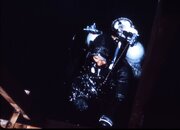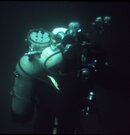I've got an exercise for you to clear your ears hands-free. Go to the local pool after a swim meet, or better a water ballet meet. Use your current gear and techniques to dive to the bottom, and look around. You are looking for lost nose clips from the divers or swim team members or performers. Now, remember that they have been in a chlorine environment for an extended time, and are therefore clean, so remove your mask and put on the nose clip. Then replace the mask, and again dive to the bottom, this time blowing gently into the mask as you descend. You will find the equalizing, still using the Valsalvo maneuver, easy and hands-free. I use it experimenting with my Hammerhead swimming device while using the dolphin kick. If you cannot equalize your mask, abort and loosen the nose clip.
This technique for hands-free equalizing is as old as skin diving itself, but has been mostly lost to current generations. It was employed by Hans and Lotte Hass in the very early days of skin diving, early 1950s. If you get Hass' book, We Came From The Sea, or Diving to Adventure, you can see both Hans and Lotte using this technique with both free diving and the special rebreather Hans developed, and under oval masks. The photography was with the Rolleimarin housing which I believe Hans also had a hand in developing, and is quite good.
SeaRat
This technique for hands-free equalizing is as old as skin diving itself, but has been mostly lost to current generations. It was employed by Hans and Lotte Hass in the very early days of skin diving, early 1950s. If you get Hass' book, We Came From The Sea, or Diving to Adventure, you can see both Hans and Lotte using this technique with both free diving and the special rebreather Hans developed, and under oval masks. The photography was with the Rolleimarin housing which I believe Hans also had a hand in developing, and is quite good.
SeaRat
Last edited:






